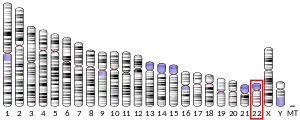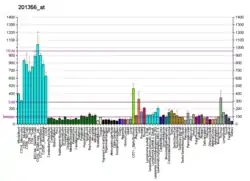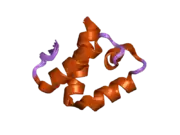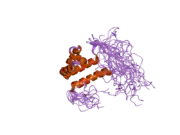| SF3A1 | |||||||||||||||||||||||||||||||||||||||||||||||||||
|---|---|---|---|---|---|---|---|---|---|---|---|---|---|---|---|---|---|---|---|---|---|---|---|---|---|---|---|---|---|---|---|---|---|---|---|---|---|---|---|---|---|---|---|---|---|---|---|---|---|---|---|
 | |||||||||||||||||||||||||||||||||||||||||||||||||||
| |||||||||||||||||||||||||||||||||||||||||||||||||||
| Identifiers | |||||||||||||||||||||||||||||||||||||||||||||||||||
| Aliases | SF3A1, PRP21, PRPF21, SAP114, SF3A120, splicing factor 3a subunit 1 | ||||||||||||||||||||||||||||||||||||||||||||||||||
| External IDs | OMIM: 605595 MGI: 1914715 HomoloGene: 4294 GeneCards: SF3A1 | ||||||||||||||||||||||||||||||||||||||||||||||||||
| |||||||||||||||||||||||||||||||||||||||||||||||||||
| |||||||||||||||||||||||||||||||||||||||||||||||||||
| |||||||||||||||||||||||||||||||||||||||||||||||||||
| |||||||||||||||||||||||||||||||||||||||||||||||||||
| |||||||||||||||||||||||||||||||||||||||||||||||||||
| Wikidata | |||||||||||||||||||||||||||||||||||||||||||||||||||
| |||||||||||||||||||||||||||||||||||||||||||||||||||
Splicing factor 3 subunit 1 is a protein that in humans is encoded by the SF3A1 gene.[5][6]
This gene encodes subunit 1 of the splicing factor 3a protein complex. The splicing factor 3a heterotrimer includes subunits 1, 2 and 3 and is necessary for the in vitro conversion of 15S U2 snRNP into an active 17S particle that performs pre-mRNA splicing. Subunit 1 belongs to the SURP protein family; named for the SURP (also called SWAP or Suppressor-of-White-APricot) motifs that are thought to mediate RNA binding. Subunit 1 has tandemly repeated SURP motifs in its amino-terminal half while its carboxy-terminal half contains a proline-rich region and a ubiquitin-like domain. Binding studies with truncated subunit 1 derivatives demonstrated that the two SURP motifs are necessary for binding to subunit 3 while contacts with subunit 2 may occur through sequences carboxy-terminal to the SURP motifs. Alternative splicing results in multiple transcript variants encoding different isoforms.[6]
Interactions
SF3A1 has been shown to interact with SF3A3[7][8] and CDC5L.[9]
References
- 1 2 3 GRCh38: Ensembl release 89: ENSG00000099995 - Ensembl, May 2017
- 1 2 3 GRCm38: Ensembl release 89: ENSMUSG00000002129 - Ensembl, May 2017
- ↑ "Human PubMed Reference:". National Center for Biotechnology Information, U.S. National Library of Medicine.
- ↑ "Mouse PubMed Reference:". National Center for Biotechnology Information, U.S. National Library of Medicine.
- ↑ Kramer A; Mulhauser F; Wersig C; Groning K; Bilbe G (January 1996). "Mammalian splicing factor SF3a120 represents a new member of the SURP family of proteins and is homologous to the essential splicing factor PRP21p of Saccharomyces cerevisiae". RNA. 1 (3): 260–72. PMC 1369079. PMID 7489498.
- 1 2 "Entrez Gene: SF3A1 splicing factor 3a, subunit 1, 120kDa".
- ↑ Nesic, D; Krämer A (October 2001). "Domains in human splicing factors SF3a60 and SF3a66 required for binding to SF3a120, assembly of the 17S U2 snRNP, and prespliceosome formation". Mol. Cell. Biol. United States. 21 (19): 6406–17. doi:10.1128/MCB.21.19.6406-6417.2001. ISSN 0270-7306. PMC 99788. PMID 11533230.
- ↑ Chiara, M D; Champion-Arnaud P; Buvoli M; Nadal-Ginard B; Reed R (July 1994). "Specific protein-protein interactions between the essential mammalian spliceosome-associated proteins SAP 61 and SAP 114". Proc. Natl. Acad. Sci. U.S.A. UNITED STATES. 91 (14): 6403–7. Bibcode:1994PNAS...91.6403C. doi:10.1073/pnas.91.14.6403. ISSN 0027-8424. PMC 44210. PMID 8022796.
- ↑ Ajuh, P; Kuster B; Panov K; Zomerdijk J C; Mann M; Lamond A I (Dec 2000). "Functional analysis of the human CDC5L complex and identification of its components by mass spectrometry". EMBO J. ENGLAND. 19 (23): 6569–81. doi:10.1093/emboj/19.23.6569. ISSN 0261-4189. PMC 305846. PMID 11101529.
Further reading
- Chiara MD, Champion-Arnaud P, Buvoli M, et al. (1994). "Specific protein-protein interactions between the essential mammalian spliceosome-associated proteins SAP 61 and SAP 114". Proc. Natl. Acad. Sci. U.S.A. 91 (14): 6403–7. Bibcode:1994PNAS...91.6403C. doi:10.1073/pnas.91.14.6403. PMC 44210. PMID 8022796.
- Rain JC; Tartakoff AM; Krämer A; Legrain P (1996). "Essential domains of the PRP21 splicing factor are implicated in the binding to PRP9 and PRP11 proteins and are conserved through evolution". RNA. 2 (6): 535–50. PMC 1369393. PMID 8718683.
- Neubauer G, King A, Rappsilber J, et al. (1998). "Mass spectrometry and EST-database searching allows characterization of the multi-protein spliceosome complex". Nat. Genet. 20 (1): 46–50. doi:10.1038/1700. PMID 9731529. S2CID 585778.
- Sanger Centre, The; Washington University Genome Sequencing Cente, The (1999). "Toward a complete human genome sequence". Genome Res. 8 (11): 1097–108. doi:10.1101/gr.8.11.1097. PMID 9847074.
- Krämer A; Grüter P; Gröning K; Kastner B (1999). "Combined biochemical and electron microscopic analyses reveal the architecture of the mammalian U2 snRNP". J. Cell Biol. 145 (7): 1355–68. doi:10.1083/jcb.145.7.1355. PMC 2133165. PMID 10385517.
- Dunham I, Shimizu N, Roe BA, et al. (1999). "The DNA sequence of human chromosome 22". Nature. 402 (6761): 489–95. Bibcode:1999Natur.402..489D. doi:10.1038/990031. PMID 10591208.
- Das R; Zhou Z; Reed R (2000). "Functional association of U2 snRNP with the ATP-independent spliceosomal complex E." Mol. Cell. 5 (5): 779–87. doi:10.1016/S1097-2765(00)80318-4. PMID 10882114.
- Gunther M; Laithier M; Brison O (2000). "A set of proteins interacting with transcription factor Sp1 identified in a two-hybrid screening". Mol. Cell. Biochem. 210 (1–2): 131–42. doi:10.1023/A:1007177623283. PMID 10976766. S2CID 1339642.
- Ajuh P, Kuster B, Panov K, et al. (2001). "Functional analysis of the human CDC5L complex and identification of its components by mass spectrometry". EMBO J. 19 (23): 6569–81. doi:10.1093/emboj/19.23.6569. PMC 305846. PMID 11101529.
- Suzuki Y, Tsunoda T, Sese J, et al. (2001). "Identification and characterization of the potential promoter regions of 1031 kinds of human genes". Genome Res. 11 (5): 677–84. doi:10.1101/gr.gr-1640r. PMC 311086. PMID 11337467.
- Will CL, Schneider C, MacMillan AM, et al. (2001). "A novel U2 and U11/U12 snRNP protein that associates with the pre-mRNA branch site". EMBO J. 20 (16): 4536–46. doi:10.1093/emboj/20.16.4536. PMC 125580. PMID 11500380.
- Nesic D; Krämer A (2001). "Domains in human splicing factors SF3a60 and SF3a66 required for binding to SF3a120, assembly of the 17S U2 snRNP, and prespliceosome formation". Mol. Cell. Biol. 21 (19): 6406–17. doi:10.1128/MCB.21.19.6406-6417.2001. PMC 99788. PMID 11533230.
- Jurica MS, Licklider LJ, Gygi SR, et al. (2002). "Purification and characterization of native spliceosomes suitable for three-dimensional structural analysis". RNA. 8 (4): 426–39. doi:10.1017/S1355838202021088. PMC 1370266. PMID 11991638.
- Will CL, Urlaub H, Achsel T, et al. (2002). "Characterization of novel SF3b and 17S U2 snRNP proteins, including a human Prp5p homologue and an SF3b DEAD-box protein". EMBO J. 21 (18): 4978–88. doi:10.1093/emboj/cdf480. PMC 126279. PMID 12234937.
- Strausberg RL, Feingold EA, Grouse LH, et al. (2003). "Generation and initial analysis of more than 15,000 full-length human and mouse cDNA sequences". Proc. Natl. Acad. Sci. U.S.A. 99 (26): 16899–903. Bibcode:2002PNAS...9916899M. doi:10.1073/pnas.242603899. PMC 139241. PMID 12477932.
- Beausoleil SA, Jedrychowski M, Schwartz D, et al. (2004). "Large-scale characterization of HeLa cell nuclear phosphoproteins". Proc. Natl. Acad. Sci. U.S.A. 101 (33): 12130–5. Bibcode:2004PNAS..10112130B. doi:10.1073/pnas.0404720101. PMC 514446. PMID 15302935.
- Nesic D; Tanackovic G; Krämer A (2005). "A role for Cajal bodies in the final steps of U2 snRNP biogenesis". J. Cell Sci. 117 (Pt 19): 4423–33. doi:10.1242/jcs.01308. PMID 15316075.
- Lin KT; Lu RM; Tarn WY (2004). "The WW domain-containing proteins interact with the early spliceosome and participate in pre-mRNA splicing in vivo". Mol. Cell. Biol. 24 (20): 9176–85. doi:10.1128/MCB.24.20.9176-9185.2004. PMC 517884. PMID 15456888.
- Collins JE, Wright CL, Edwards CA, et al. (2005). "A genome annotation-driven approach to cloning the human ORFeome". Genome Biol. 5 (10): R84. doi:10.1186/gb-2004-5-10-r84. PMC 545604. PMID 15461802.
External links
- SF3A1 human gene location in the UCSC Genome Browser.
- SF3A1 human gene details in the UCSC Genome Browser.










